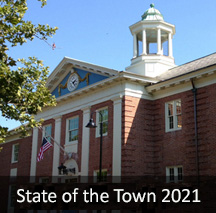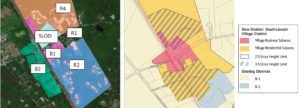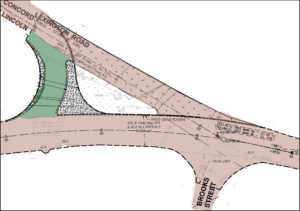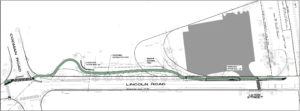 Planning officials will keep working on revising the zoning bylaw to encourage business and mixed-use development in South Lincoln, in keeping with the town’s comprehensive plan and vision statement as well as pressure from the state to allow denser development near MBTA stops.
Planning officials will keep working on revising the zoning bylaw to encourage business and mixed-use development in South Lincoln, in keeping with the town’s comprehensive plan and vision statement as well as pressure from the state to allow denser development near MBTA stops.
Planning Board Margaret Olson summarized the past and current work in this area at the second State of the Town meeting on November 2. The meeting also featured discussions surrounding two new organizations, the Climate Action Planning Committee and the Inclusion, Diversity, Equity and Antiracism Initiative (see below).
About four years ago, the board created the South Lincoln Planning Advisory Committee (SLPAC) to map out easy to “create a compact, vital, walkable village center in the Lincoln Station area that provides more housing choices near public transportation, goods and services for residents and opportunities for social interaction” as per Lincoln’s 2009 Comprehensive Plan. In May 2018, SLPAC unveiled proposed zoning changes that met with strong opposition from residents worried about changing the town’s character and shifting too much power for approving development projects from Town Meeting to the Planning Board.
More recently, the reorganized SLPAC published a town-wide survey on South Lincoln. The results revealed, among other things, that a large majority of respondents want to retain a village center with commercial businesses and support the economic viability of those businesses.
“We believe we need to do something down by South Lincoln in order to achieve this,” Olson said. “The commercial viability [in that area] is marginal.”
Olson explained that the board is not aiming to increase the amount of space devoted to commercial uses. “What we’re really talking about is, if the mall is redeveloped, allowing housing on a second story and permitting mixed-use” developments, she said. “We’re not going to attempt to build some sort of giant mall — we want to promote a sense of place and community.”
Olson summarized the hodgepodge of zoning districts in South Lincoln and the difficulty faced by potential developers in proposing projects that can ultimately win approval — especially when an up-or-down vote is required at Town Meeting where it’s not possible in practice for residents to propose amendments to plans.
- See the South Lincoln zoning slides shown at the State of the Town
Another issue is that most businesses are required to secure a time-limited special permit that can’t be later transferred to a new owner. “This is kind of a scary thing — you need a special permit and then it expires and then what do you do? This is a big deterrent,” she said. “We believe a new zoning bylaw will get us better projects.”
Even if the town relaxes some limitations in the bylaw, “there’s nothing that prevents us from being extremely specific about what we do and do not want” in terms of a building’s overall appearance, materials used, etc., as well as requiring traffic and fiscal studies, green buildings, community spaces, and/or affordable housing, she said. “It provides parameters for developers… they know what they need to do and we know what we’re going to get.”
Another source of pressure for change is the Housing Choice and MBTA Community legislation passed by the state legislature earlier this year. Though it’s not yet being enforced, the legislation requires a multifamily housing zone near MBTA stops such as Lincoln’s commuter rail station. If a town doesn’t comply by allowing such development, it stands to lose what could be a considerable amount of money in state grants.
“The town really does have a decision to make about how much we care… We don’t actually have to do this,” Olson said. It’s also unclear what exactly will satisfy the state requirements. “It says the district has to be of ‘reasonable size’ but we don’t know what that means,” she added.
In a Q&A session, several residents reiterated their criticism of the survey, but Olson was clear that “we do not intend to redo the survey. We understand what people’s frustrations were and it was very helpful to hear those viewpoints,” but the survey “is just one small piece of information among many.”
Sara Mattes argued against the proposed changes. “It’s not clear what problem we’re really trying to solve,” she said. If the mall’s financial struggles are the primary concern, “the driver is for us to sit down with RLF and Community Builders [owners of Lincoln Woods and the South Lincoln wastewater treatment plant] and work on a solution directly.” She also noted that there are numerous apartment and condominium complexes in town where downsizing residents can move.
But Sasha Golden, a resident of Farrar Pond Village, pushed back, noting that vacancies occur only when a unit’s owner dies. “To make a sweeping assumption that we have all these different sites is really missing the actual day-to-day issue of vacancy and affordability.”
“I disagree with Sara. I would love to see market forces deciding what housing and development should come to Lincoln for once,” said Jim Hutchinson, describing himself as an “unrepentant capitalist.” Saying that the economic environment in South Lincoln is “not good,” he decried those who “don’t want any change without 15 committees to approve it first… I think it’s good for some experimentation to be allowed in this town.
Terry Perlmutter, a realtor, argued that the town needs more affordable housing. Developments such as those mentioned by Mattes may be perceived as affordable, “but affordable to whom? They are just the ‘more affordable’ housing in an expensive community.”
Climate Action Planning Committee
A new town group urged residents to follow the example of many neighboring towns and fund a sustainability manager position while also developing a climate action plan
The Climate Action Planning Committee (CAPC, a subgroup of the Green Energy Committee) made its pitch at the second State of the Town meeting on November 2.
The Commonwealth recently passed a climate roadmap calling for net zero greenhouse gas emissions by 2050, “and state goals cannot be met unless cities and towns do their part,” CAPC member Sue Klem said.

A Zoom poll during the State of the Town meeting asked attendees what fuel types they use to heat their home and power their cars (click to enlarge).
A climate action looks at reducing carbon emissions from things like buildings, transportation, electrical generation and land use, she explained. Examples of specific town-wide actions might include energy retrofits on buildings, changes in the building code, electrifying town vehicle fleets and tools, and installing electric vehicle charging stations.
- See the Climate Action Planning Committee slides shown at the State of the Town
Lincoln, like several other towns in the region, has produced a greenhouse gas emissions report (which will be updated soon) and offered community choice for electricity. Before the Green Energy Choice program began, only 16% of electricity consumed in town was from wind and solar, but that figure is now up to 45%, she noted. However, it has not yet followed the area’s lead in establishing a climate action plan, which will provide “the structure and guidance we will need to address the climate crisis.”
The town should also hire a sustainability manager to help plan and promote green policies, Klem said. The cost for that position could be mostly or entirely offset by grants, she added.
The CAPC is in the process of talking to town boards and committees and will host a public frum in the next few weeks to hear questions and comments in preparation for submitting a warrant article for the ATM this spring.
IDEA Initiative
A group of residents was recruited earlier this year to make recommendations on establishing a new committee that would investigate unconscious bias and actively promote an antiracist community.
In September, the Select Board formally allowed the IDEA Initiative to pivot from designing a committee and simply become that committee. They plan to research efforts by other towns (some of whom have hired diversity coordinators), partnering with the Welcome, Inclusion, Diversity, Equity group and the schools, and securing funding and hiring a consultant on equity measures “to keep Lincoln’s vision of fostering and supporting diversity at the center,” IDEA member Jen James said. Among the possibilities: a town-wide 21-day group challenge to discuss and reflect on readings, videos, and podcasts.
Among the questions IDEA is wrestling with: “What does racism look like in Lincoln? Where does classism exist? What is Lincoln willing or unwilling to change to become a truly antiracist town? We want to be taking action, not just making recommendations,” she said.

 The first phase of an engineering study of the wastewater treatment plant near the mall shows that it’s working well and has additional capacity to handle some commercial or residential development in the area.
The first phase of an engineering study of the wastewater treatment plant near the mall shows that it’s working well and has additional capacity to handle some commercial or residential development in the area.



